
Pope Honorius III, born Cencio Savelli, was head of the Catholic Church and ruler of the Papal States from 18 July 1216 to his death. A canon at the Basilica di Santa Maria Maggiore, he came to hold a number of important administrative positions, including that of Camerlengo. In 1197, he became tutor to the young Frederick II. As pope, he worked to promote the Fifth Crusade, which had been planned under his predecessor, Innocent III. Honorius repeatedly exhorted King Andrew II of Hungary and Emperor Frederick II to fulfill their vows to participate. He also gave approval to the recently formed Dominican and Franciscan religious orders.
The 620s decade ran from January 1, 620, to December 31, 629.
The 630s decade ran from January 1, 630, to December 31, 639.
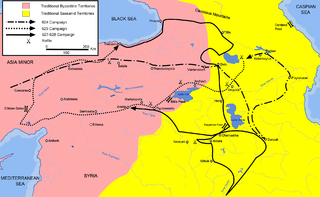
Year 625 (DCXXV) was a common year starting on Tuesday of the Julian calendar. The denomination 625 for this year has been used since the early medieval period, when the Anno Domini calendar era became the prevalent method in Europe for naming years.

Year 641 (DCXLI) was a common year starting on Monday of the Julian calendar. The denomination 641 for this year has been used since the early medieval period, when the Anno Domini calendar era became the prevalent method in Europe for naming years.
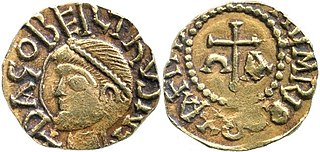
Dagobert I was King of the Franks. He ruled Austrasia (623–634) and Neustria and Burgundy (629–639). He has been described as the last king of the Merovingian dynasty to wield real royal power, after which the Mayor of the palace rose as the political and war leader. Dagobert was the first Frankish king to be buried in the royal tombs at the Basilica of Saint-Denis.

Charles IV, called the Fair in France and the Bald in Navarre, was last king of the direct line of the House of Capet, King of France and King of Navarre from 1322 to 1328. Charles was the third son of Philip IV; like his father, he was known as "the fair" or "the handsome".

René of Anjou was Duke of Anjou and Count of Provence from 1434 to 1480, who also reigned as King of Naples from 1435 to 1442. Having spent his last years in Aix-en-Provence, he is known in France as the Good King René.
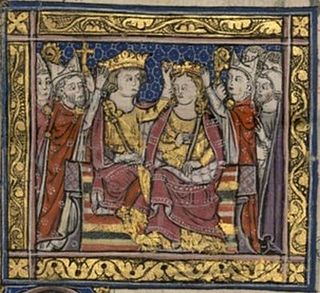
John of Brienne, also known as John I, was King of Jerusalem from 1210 to 1225 and Latin Emperor of Constantinople from 1229 to 1237. He was the youngest son of Erard II of Brienne, a wealthy nobleman in Champagne. John, originally destined for an ecclesiastical career, became a knight and owned small estates in Champagne around 1200. After the death of his brother, Walter III, he ruled the County of Brienne on behalf of his minor nephew Walter IV.
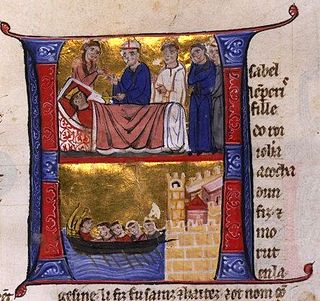
Isabella II, sometimes erroneously called Yolanda, was Queen of Jerusalem from 1212 to 1228. She was the daughter of Queen Maria of Jerusalem and her husband, John of Brienne. By marriage to Frederick II, Holy Roman Emperor, Isabella also became Holy Roman Empress and Queen of Sicily and Germany.
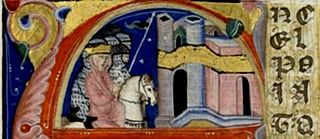
Alice of Champagne was the queen consort of Cyprus from 1210 to 1218, regent of Cyprus from 1218 to 1232, and regent of Jerusalem from 1243 to 1246. She was the eldest daughter of Queen Isabella I of Jerusalem and Count Henry II of Champagne. In 1210, Alice married her stepbrother King Hugh I of Cyprus, receiving the County of Jaffa as her dowry. After her husband's death in 1218, she assumed the regency for their infant son, King Henry I, but her maternal uncle Philip of Ibelin became the actual head of state administration as bailli (governor).
Dagobert or Taginbert is a Germanic male given name, possibly from Old Frankish Dag "day" and beraht "bright". Alternatively, it has been identified as Gaulish dago "good" berxto "bright".

Maria Antonia of Naples and Sicily was the youngest surviving daughter of Ferdinand, King of Naples and Sicily, and Maria Carolina of Austria. As the wife of the future Ferdinand VII of Spain, then heir apparent to the Spanish throne, she held the title of Princess of Asturias. It was rumoured that her mother-in-law, Maria Luisa of Parma caused her death, but there is no evidence to prove this.
Raoul of Mérencourt was the Latin Patriarch of Jerusalem from 1214 to 1224, succeeding the assassinated Albert Avogadro.
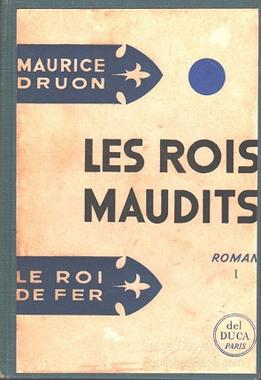
The Accursed Kings is a series of seven historical novels by French author Maurice Druon about the French monarchy in the 14th century. Published between 1955 and 1977, the series has been adapted as a miniseries twice for television in France.

Louis III was a claimant to the Kingdom of Naples from 1417 to 1426, as well as count of Provence, Forcalquier, Piedmont, and Maine and duke of Anjou from 1417 to 1434. As the heir designate to the throne of Naples, he was duke of Calabria from 1426 to 1434.

"Le bon roi Dagobert" is a French satirical anti-monarchical and anti-clerical song written around 1787. It references two historical figures: the Merovingian king Dagobert I and his chief advisor, Saint Eligius (Éloi), the bishop of Noyon. The song is directed against Louis XVI and the ties maintained by the Catholic Church with the ancien régime, but it was used more broadly against monarchies in French history.

Maria Luisa of Parma was, by marriage to King Charles IV of Spain, Queen of Spain from 1788 to 1808 leading up to the Peninsular War. Her relationship with Manuel Godoy and influence over the King made her unpopular among the people and aristocrats. She was rivals with the Duchess of Alba and the Duchess of Osuna. The death of her daughter-in-law Princess Maria Antonia of Naples and Sicily, whom she disliked, was said to be the result of poisoning by the Queen.

Maria Isabella of Spain was Queen of the Two Sicilies from 4 January 1825 until 8 November 1830 as the wife of Francis I of the Two Sicilies.

Vieux sequins et vieilles cuirasses(Old Sequins and Ancient Breastplates) is a 1913 piano composition by Erik Satie. One of his humoristic keyboard suites, it was published by the firm E. Demets that year but not premiered until 1917. In performance it lasts about 5 minutes.
















